Description
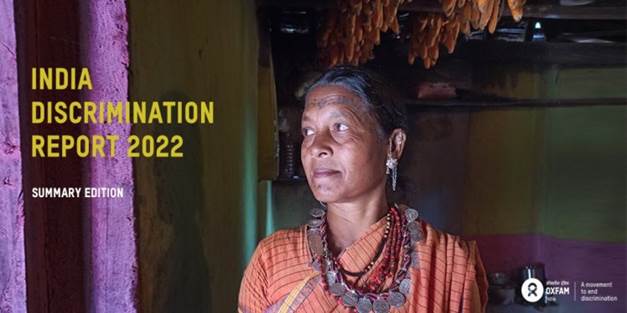
Disclaimer: Copyright infringement not intended.
Context
- Gender-based discrimination is the reason for 98 percent of the employment gap between males and females in urban India, an extensive analysis by Oxfam India has found.
Further Findings of the India Discrimination Report 2022 (by Oxfam India)
Labour force participation rate (LFPR)
- Labour force participation rate (LFPR) of women in India was just 25 per cent in 2021. It is considerably lower than Brazil, Russia, China and South Africa, it added citing the latest World Bank estimates.
- LFPR of women was 42.7 per cent in 2004-05, and the significant decline indicates the withdrawal of women from the workforce despite rapid economic growth during the same period.
- The low participation was largely due to gender discrimination in wages and opportunities,
Wage Gap
- Self-employed urban males earn 2.5 times more than their female counterparts. 83 percent of this wage gap is attributed to gender-based discrimination.
- The research found that discrimination against women in India is so high that there is hardly any difference observed across religious and caste-based sub-groups. All women, regardless of their socio-economic position, are highly discriminated against.
- In rural areas, 93 per cent of the gap in earnings between men and women is due to gender discrimination.
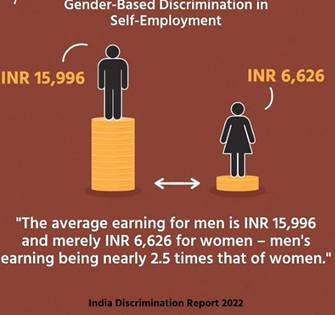
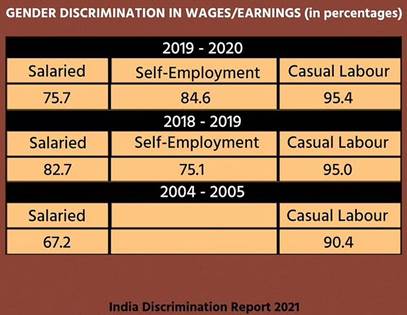
Discrimination delinked with educational qualifications
- The employment status of women does not depend on their educational qualifications. This leads to the alarming result emerging from a mathematical model that gender discrimination is almost total in the country. This is partly because women candidates are not selected by employers due to their gender-linked prejudices.
Social Norms
- A sizable segment of qualified women is not available in the labor market because of “family responsibilities” or the need to conform to social norms, status within the caste hierarchy and community, family traditions, etc, that are often at odds with participation in the labour force.
- Women in well-educated and economically better-off households often withdraw from the labour force due to socio-cultural reasons.
- Women do not enter the labour market due to “family reasons,” a lack of safety associated with travelling and timing requirements of jobs in addition to esoteric reasons ranging from “societal norms” and practices that associate respectability with staying out of the workforce for women."
Lack of salaried jobs
- 60 percent of urban men are engaged in salaried jobs or are self-employed, whereas this figure is reduced to a mere 19 percent for women.
- While 53.8 percent of the 15+ population of men is engaged in salaried or self-employed work in rural areas, the figure for women is 23.3 percent only.
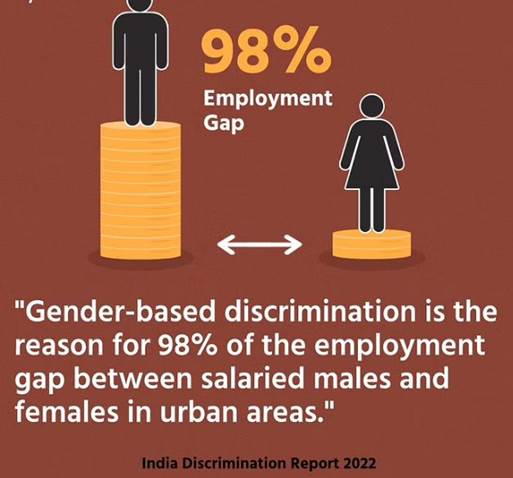
Scenario in rural areas
- In rural areas, any “social capital” gains, in terms of the education of the heads of households, reduce women’s probability of participation in regular salaried or self-employed work, implying that women from such households are less likely to seek and get jobs.
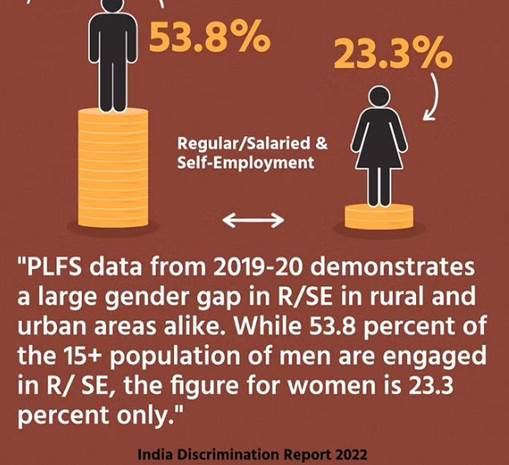
Exception of SC, ST communities
- There is a deviation for women belonging to Scheduled Caste and Scheduled Tribe communities, as observed by the Oxfam India study.
- SC and ST women start working at an early age without any formal education due to desperate socio-economic conditions, the report noted. This means that more than educational qualifications or age, social factors are greater determinants for rural women stepping out – or keeping away – from work.
- Notably, persons belonging to SC and ST communities earn Rs 5,000 less than the national average.
Effect of COVID-19: Key Findings
- Women during the first quarter of the pandemic (April-June 2020) recorded massive increase in their unemployment rate, similar to that of men in urban areas. However, in rural areas, the unemployment rate for women was less than that of men over the same period. The diminished effect of COVID-19 and subsequent lockdowns on women employment in rural areas could be due to women being engaged in agriculture and home-based activities in rural areas.
- The urban unemployment rate for women did not rise above men because a large segment of women workers were engaged as domestic help and in unskilled jobs, on a regular basis, which saw less impact.
- The pandemic-induced lockdowns constrained the mobility of women much more than men, resulting in high employment losses in urban areas.
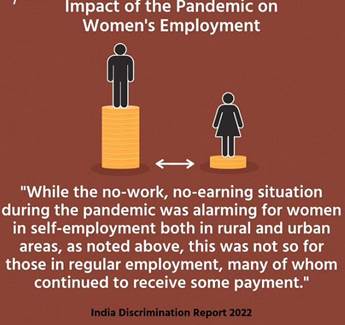
Recommendations to address the discrimination
To tackle these concerns, Oxfam India recommends the following policy interventions:
- Actively enforce legislations for the protection of the right to equal wages and work.
- Work to actively incentivize the participation of women in the workforce, including enhancements in pay, up skilling, job reservations, easy return-to-work options, particularly after maternity leave, and the option to work from home, wherever possible.
- Work to ensure a more equitable distribution of household work and childcare duties between women and men.
- Implement “living wages” as opposed to minimum wages, particularly for all informal workers, and formalise contractual, temporary, and casual labour as much as possible.
Other Reasons behind poor Labor Force Participation of women in India
Occupational segregation
- Between 1977 and 2017, India’s economy witnessed a surge in the contribution of services (39 percent to 53 percent) and industry (33 percent to 27 percent) to GDP.
- The proportion of rural men employed in agriculture fell from 80.6 percent to 53.2 percent, but rural women only decreased from 88.1 percent to 71.7 percent (NSSO data).
Increased mechanization
- In agriculture, and as the use of seed drillers, harvesters, threshers and husking equipment increased, men displaced women. In textiles, power looms, button stitching machines and textile machinery phased out women’s labour.
- Nearly 12 million Indian women could lose their jobs by 2030 owing to automation, according to a McKinsey Global Institute report.
The income effect
- With increasing household incomes, especially over the last three decades, the need for a “second income” reduced. Consequently, families withdrew women from labour as a signal of prosperity.
Gender gaps in higher education and skill training
- Tertiary-level female enrolment rose from 2 percent in 1971 to only 30 percent in 2019 (World Bank data).
- As of 2018-19, only 2 percent of working-age women received formal vocational training, of which 47 percent did not join the labour force (NSSO, 2018-19).
- Consequently, women form only 17 percent of cloud computing, 20 percent of engineering, and 24 percent of data/artificial intelligence jobs (WEF, 2020).
Social norms
- Unpaid care work continues to be a women’s responsibility, with women spending on average five hours per day on domestic work, vs. 30 minutes for men (NSSO, 2019).
- Women face inordinate mobility restrictions such that only 54 percent can go to a nearby market alone (NFHS, 2015-16).
- Women regularly sacrifice wages, career progression, and education opportunities to meet family responsibilities, safety considerations, and other restrictions.
- In this context, the COVID-19 pandemic has come as a shock, resulting in massive job losses for women, especially informal workers, and slower recovery of women-led micro-businesses.
- It has also increased domestic work, deepened gender digital divides, disrupted girls’ schooling and placed millions of female health workers at risk.
|
Trivia
· Low female Labor Force Participation Rate is a drag on GDP growth and a higher growth path.
· China has 64% of its women working, which is one of the highest rates in the world. In the US, the rate is over 56%.
· Even countries like Nepal and Bangladesh are doing much better than India.
· At 17% of GDP, the economic contribution of Indian women is less than half the global average and compares unfavorably to 40% in China.
|
Other challenges faced by Women Workforce in India
- More women in the rural area in the labor force Compared to Urban areas.
- Gender wage gaps remain in every employment.
- Double burden on women: Balancing employment and domestic responsibilities (including household chores and care giving).
- Safety concerns, Sexual harassment at work place.
- Migration, Unfair Sex ratio, Environmental degradation have added to the women’s vulnerability.
- India is a male dominated Society in which the Economic, Political, Religious, Social and Cultural institutions are largely controlled by men.
- Control over women’s livelihood Choices and Sexuality has existed and evolved over Centuries through various discriminatory Social Practices and Institutions.
- Despite laws, gender based discrimination against women continue in Indian Society. Clearly shows the laws and gaps in their implementation.
- Structure of Judicial remedies is still insufficient to serve the needs of women, Particularly Poor and marginalized women, in accessing justice.
- Development Programmes introduced to bring gender equality have Produced mixed results. Legislative Changes have faced resistance in their implementation due to Social, Cultural and religious Custom.
- There is no comprehensive policy support and there is a lack of its effective implementation.
- There is a lack of match between the aspirations of more educated women and the quality and availability of jobs. Further, there is a lack of salaried opportunities available for women with moderate levels of education.
- Insufficient formal wages and poor job opportunities are other reasons for the decline.
- While social norms and family commitments are important issues, factors such as terms of employment, working conditions, mobility limitations, and hiring practices also make things difficult.
- Women’s workforce participation is declining in rural India and is low and stagnant in urban India, primarily due to the shrinking of the agriculture sector.
- Lack of formal enterprises and the absence of having 200 cities with 30-minute safe commutes explain a lot, if not most, of
this tragedy.
- A large proportion of the women who left the labor market are
- Many women who join the workforce are unable to re-join after having a child.
- If women's perceived productivity at home is greater than their returns in the labor market, women are likely to withdraw
from the labor force.
- Barriers to migration for women, Discrimination, at the Workplace are other factors.
Steps taken by Government to improve women labour force participation
- Scheme for Adolescent Girlsaims at girls in the age group 11-18, to empower and improve their social status through nutrition, life skills, home skills and vocational training
- Pradhan Mantri Mahila Shakti Kendra scheme, promote community participation through the involvement of Student Volunteers for the empowerment of rural women
- National Crèche Schemeto provide daycare facilities to children of the age group of 6 months to 6 years of working women who are employed.
- Rashtriya Mahila Kosh (RMK)to provide micro-credit to poor women for various livelihood support and income-generating activities at concessional terms
- Working Women Hostelsfor ensuring safe accommodation for women working away from their place of residence.
- SABLA Scheme, Providing life Skills and Supplementary nutrition to out of School girls
- Sexual Harassment of Women at Workplace Act 2013 -Cover all women, of all age , both in public and private sector, whether organized or unorganized.
- The Government enhanced paid maternity leave from 12 weeks to 26 weeks, provision for mandatory crèche facilities in the establishments having 50 or more employees, permitting women workers in the night shifts with adequate safety measures, etc.
- The Equal Remuneration Act, 1976 now subsumed in the Code on Wages, 2019 provides that there shall be no discrimination in an establishment on the ground of gender in matters relating to wages by the same employer, in respect of the same work or work of similar nature done by any employee.
- To enhance the employability of female workers, the Government is providing training to them through a network of Women Industrial Training institutes, National Vocational Training Institutes and Regional Vocational Training Institutes.
- 'Mission Shakti'.

The Mission Shakti, includes the components such as;
- National, State and District level Hubs for Empowerment of Women.
- Women Hiplines, One Stop Centres.
- Beti Bachao Beti Padhao, Sakhi Niwas (Working Women’s Hostels).
- Palna (crèches for children of working women) etc.
- The schemes of One Stop Centres and Universalization of Women Helpline are implemented by the Ministry of Women and Child Development to support women facing violence or distress of any kind which may adversely affect their participation in the workforce.
Importance of Women in the workforce for India
- IMF: India’s GDP could expand 27%if the number of female workers increases to the same level as that of men.
- India could boost its growth to 9% per year if around50% of women could join the workforce.
Micro-level:
- Financially independent and greater control over their own lives.
- They will stand against physical and emotional abuse.
- They will handle social issues and pressures on their own.
Macro-level:
- Good for the overall economy.
- McKinsey Global Institute report 2016: increasing gender parity, India can add $700 billion to the global GDP.
- Because women bring new skills to the workplace, the productivity and growth gains from adding women to the labor force are manifold.
- Men’s wages will also increase as a result of greater inclusion of women in the labor force since productivity will increase.
- Women help build an inspiring work culture by bringing in healthy competition, fostering teamwork, bonding and thereby
helping the company grow to its full potential.
Suggestions to increase women workforce
- Need to Integrate Policy of Work, Livelihoods, Earnings and Poverty, Re‐think and Integrate macroeconomic Policy with Social Policy.
- Convergence with programs for adult education, literacy, and advanced skill training and higher education.
- Using tax policies to incentivize women into the labor market on both the demand and supply side.
- Communication and Behavioural Change.
- Support Services for Entry and Continuation: eg- child care facilities, migration facilities, forums for informal and formal mentorship and connections.
- Infrastructure and norms play a crucial role in impeding women's sentry and sustenance in the workforce. The gender-sensitive infrastructure included full-time creches for children, affordable and safe working women's hostels, and basic public provisions such as piped water, hygienic washrooms at public places and safe public transport for enabling women to access decent and dignified livelihood opportunities.
- Improve women’s access to Credit, skills, marketing.
- Pay regular wages to Asha workers, Anganwadi teachers and helpers, cooks for mid‐day meals and regularize their employment.
- Improve working conditions for women.
- Investments in childcare facilities and toilets for women at all workplaces.
- Sensitisation on issues such as sexual division of labour within the home through large scale media advertisement.
- Implementation of minimum wage laws.
- Enable universal access to high quality public health care facilities and support for women's care.
- All women workers should have identity cards and be covered under Unorganized Sector Social Security Act, 2008.
- Secure and uphold women’s ownership rights over basic productive resources like land - Create equal rights to property.
- Focus on primary health so that private expenses and indebtedness on account of health and hospitalization can be eliminated.
- A minimum social security package available to all citizens that include life insurance, disability insurance, health insurance, and pensions offered through multiple distribution channels.
- Safer transport and cities, Change at home with an equitable distribution of work traditionally done by women.
- Change in Social norms and mindsets towards girls and women can be brought about through institutional initiatives. This involves the family, Community, religious and educational institutions.
- Strengthen and ensure implementation of economic and Social Policies for gender equality.
https://www.downtoearth.org.in/news/governance/women-in-workforce-low-participation-majorly-due-to-gender-discrimination-says-new-oxfam-report-84966




















